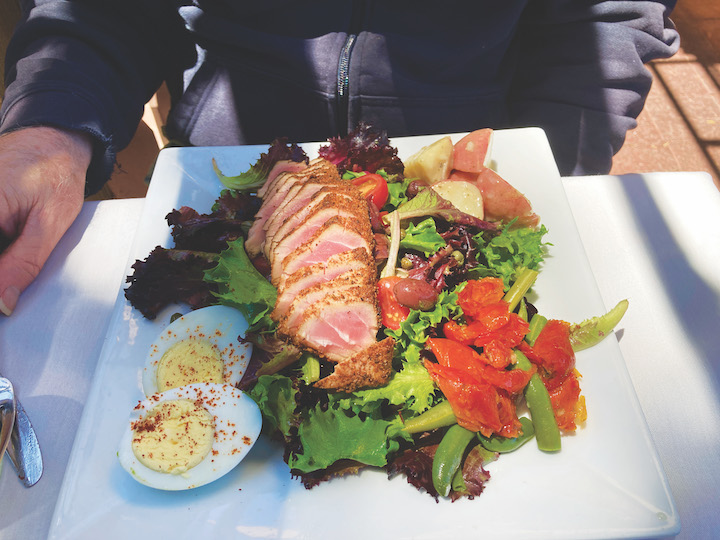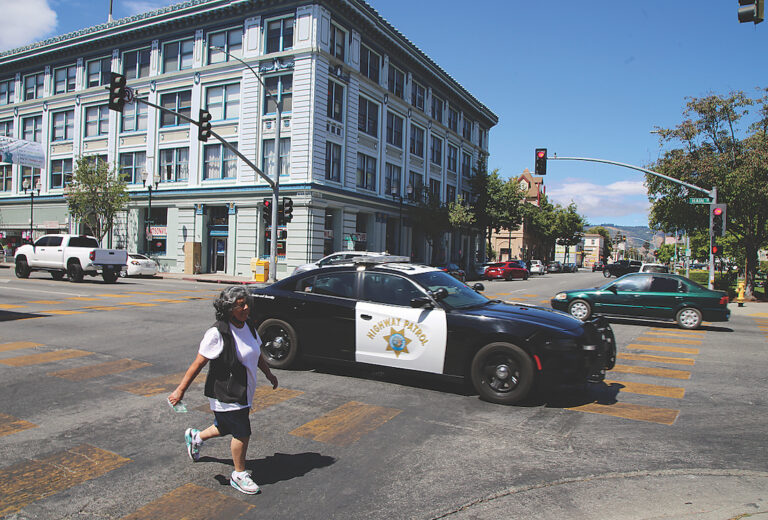Polished and gleaming, the Shadowbrook wears its age gracefully. In fact, its seven decades of dining give it several things few places today can offer—grace, a touch of class and pride in the authentic touches that make dining here memorable. It’s famous for its acres of gleaming woodwork, polished brass accents, the well-kept gardens lining the serpentine walkway down from street level. The ladies room offers the sort of cushioned, wallpapered luxury you associate with Elizabeth Taylor movies and wedding receptions.
Shadowbrook is the local go-to spot for special occasions, and the terrace at lunchtime last week was hosting a large family gathering, and a 13th birthday lunch. Meanwhile, we were returning to check out the summertime lunch at this fabled dinner house. “We’ve never had a bad meal here,” my companion recalled as he checked out the menu—salads, pizzas and a few choice entree sandwiches. On the contrary, we’ve had some mighty fine meals here at the restaurant my parents too used to frequent, and which owner Ted Burke still hosts with style.
I am such a fan of those addictive bacon-wrapped prawns that I didn’t think twice about ordering us a small plate of four ($11.50) to start off lunch. Char-grilled in a tangy soy glaze, these decadent appetizers can’t be beat. Especially dipped in the pickled ginger or sesame-mustard sauce. A gorgeous pizza was brought over to the adjoining table, the kind with the blistered crust that had us reminiscing about Rome. Waiting for our main dishes, we surveyed the drinks list and noticed a charming selection of Retro Favorite cocktails culled from 70 years of expertise. Old-Fashioneds, Negronis, Sazeracs, a Tequila Sunrise—remember when those were on every menu? Great prices on these and all the cocktails. Instead of insisting on updating itself, from menu to decor, Shadowbrook trusts its instincts. Patrons come here wanting to enjoy the classic menus that can’t be improved upon.
So yes, I did want a house burger ($16.95) with bacon jam ($2.95) and cheese ($2.25) (brie on top, please!), and my companion succumbed to an item once found on every menu in California: a seared Ahi Salad Niçoise ($22.95). A giant bottle of icy San Pellegrino ($5) was the perfect partner on the warm mid-day.
The service at Shadowbrook was perfect. Our waitperson made sure we had any extras we wanted, and responded to questions or requests with a friendly can-do attitude. What a pleasure to find well-trained and engaging service, especially given the issues restaurants have faced during the past two years of upheaval. Arriving along with salt and pepper grinders and a little pot of ketchup, my burger was gorgeous, glistening under a glaze of thick bits of bacon in an onion jam, topped with long strips of melting Brie. In a delicious bun, one side open to reveal sliced tomatoes, the burger was just plain wonderful. The burger you want when you want a burger. Coleslaw on the side made perfect sweet/tangy sense with the rich beef. The ahi Niçoise was huge and gorgeous. Slices of seared pink tuna fanned out across a generous salad of fresh baby greens. A sliced hardboiled egg sprinkled with paprika, little red potatoes, green beans, sundried tomatoes, capers and yes, pungent niçoise olives. What an array! The vinaigrette lightly drizzled over the entire creation pulled every bite into delicious focus. I took one last look at the hillside filled with blooming nasturtiums as we made our way back up the fragrant garden walkway. When you go to Shadowbrook for lunch this summer, make sure you go early. Everybody wants those outdoor tables.
Shadowbrook, 1750 Wharf Road, Capitola. Lounge and Patio, daily noon -10pm. Dining room, M-F 4-8:30pm; weekends from 2pm. shadowbrook-capitola.com.






















